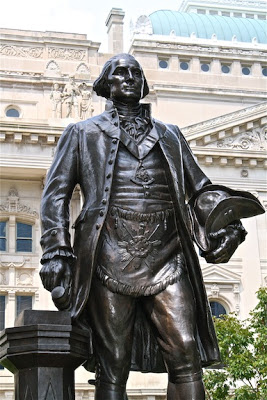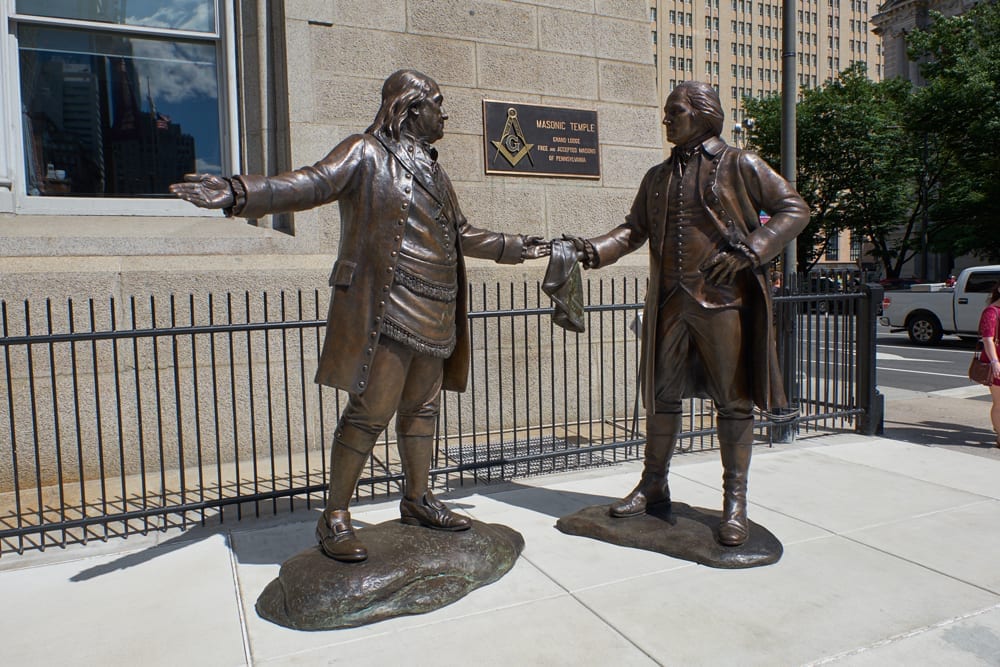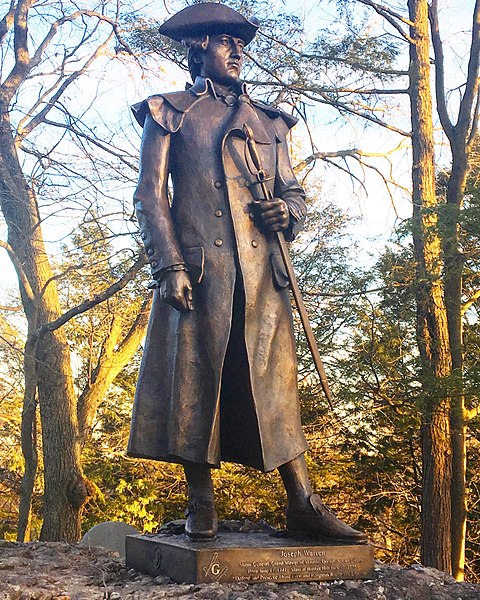Read on to explore some significant bronze statues throughout the United States that honor Freemasons.
George Washington as Master Mason, Indianapolis, IN
American sculptor Donald De Lue created this public artwork depicting Brother George Washington standing in the South Lawn of the Indiana State House. The bronze statue depicts George Washington clothed in a Masonic apron and medallion decorated with Masonic symbols. Records indicate that De Lue was inspired by the work of another sculptor, Bryant Baker. Baker’s Illustrious Brother George Washington also depicts Washington in a similar pose to De Lue’s sculpture adorned in similar Masonic symbolism. On the East side of the base of the statue, an inscription reads:
My attachment to the Society of which we are members will dispose me to contribute my best endeavors to promote the honor and interests of the Craft – George Washington, Freemason 1753–1799

The Bond, Philadelphia, PA
Positioned across from City Hall in Philadelphia, PA, The Bond guards the doors of the Masonic Museum and Library proudly. This sculpture depicts the dreams of independence, where men united to create a place where democracy would thrive. The bronze statue shows Benjamin Franklin handing Lafayette’s Masonic apron to Washington, depicting the bond founded by a desire for independence.
Sculptor James A. West crafted a story in this statue. It starts with Ben Franklin and his coat etched with nine lines to represent the location in Paris where Franklin and his fellow diplomats discussed a government ruled by the people. These spoken dreams of freedom would have been considered treasonous at the time. Franklin’s diplomacy in France was instrumental in America’s war for independence. George Washington was Commander and Chief of the Continental Army at the time, and Marquis de Lafayette gifted him a Masonic Apron. When representing this story in bronze, the artist mentioned the following:
“I was commissioned to do a sculpture of prominent Masons to be placed in front of the Grand Lodge Masonic Library and Museum in Philadelphia Pennsylvania. I met with historians from the Library and we discussed astronauts, writers, sports figures, and world leaders. I wanted the sculpture to be an American story and possibly tie it to artifacts found in the Museum. Inside the museum there’s a Masonic apron that was a gift from Lafayette to George Washington. Therefore, I thought about the story of three men – Benjamin Franklin, the diplomat who negotiated France’s involvement in the American revolution; George Washington, the Commander-in-Chief of the Continental Army; and Lafayette, the French General. THE BOND is about that relationship and their individual involvement in the American Revolution. Also, while Benjamin Franklin was in Paris, he spent time at the Paris Masonic Lodge of the Nine Sisters with Jean Antoine Houdon the artist, and Voltaire the writer. They discussed having a country without a King or Monarch, but being ruled by the people in a democracy. At that time this was heresy. On the sculpture, inside the coat of Benjamin Franklin, I marked nine female lines representing the Lodge’s nine sisters – the classic muses presiding over the arts and sciences. The apron being presented in the sculpture represents THE BOND between the countries, the men and their ideas. We the people. THE BOND.” – James A. West.

Joseph Warren Statue, Boston, MA
Located in Forest Hills Cemetery in Boston, MA, there is a bronze statue of Joseph Warren. Robert Schure of Skylight Studios crafted this replication inspired by Paul W. Bartlett. The statue sits atop a large boulder, not far from Brother Warren’s grave in the Forest Hills Cemetery.
Warren was an American physician who had a significant role in organizing patriots throughout Boston, MA at the start of the American Revolution. Despite his status as General, he served in the Battle of Bunker Hill alongside his men as a private soldier. He was killed during this battle as British troops stormed the site. While he practiced medicine and surgery in Boston, Brother Warren joined Lodge St Andrews No. 81. He was Worshipful Master of this Lodge in 1769 and Bro. Paul Revere served as Secretary. In the same year, Bro. Warren was appointed Grand Master of the newly established Provincial Grand Lodge of Massachusetts to be followed by John Hancock upon his death.

Have you visited any of these Masonic statues? Share with us at OhioLodgeLife@gmail.com, or find us on Facebook and Twitter.